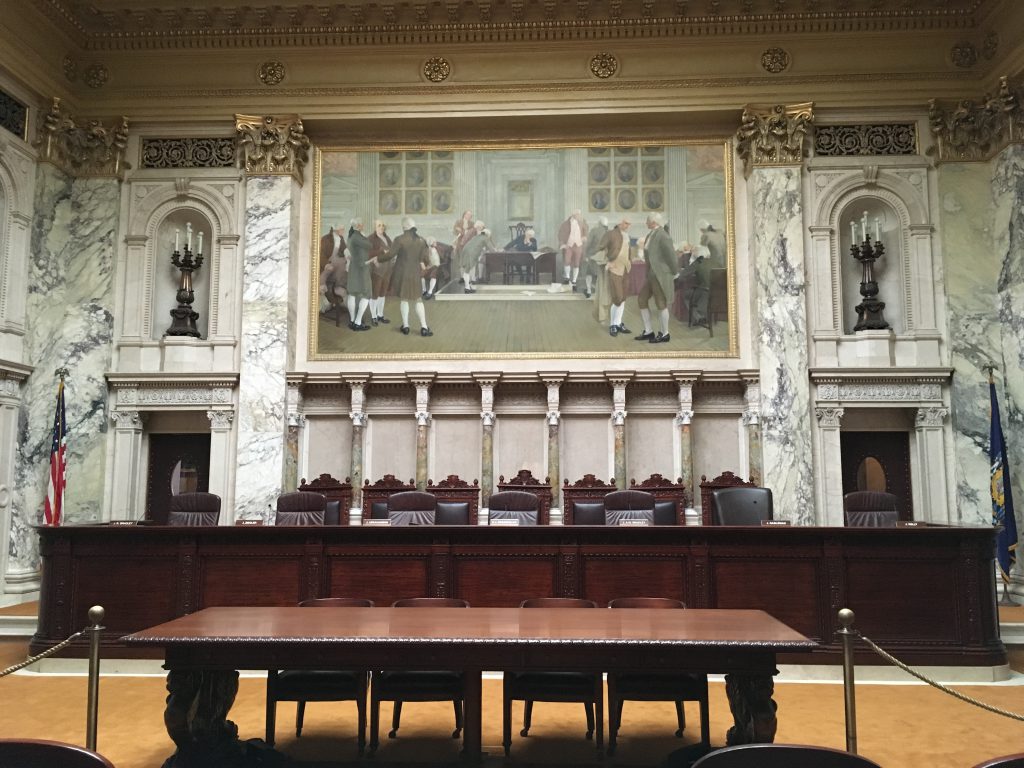Wisconsin Supreme Court Hears Arguments In Gerrymandering Case
Case, before court’s now-liberal majority, could overturn Republicans’ entrenched advantage.
The Wisconsin Supreme Court heard oral arguments Tuesday in the lawsuit that could toss out the maps that have entrenched Republican control of the Legislature since 2011. The arguments were by turns complex and technical, as lawyers debated the meaning of the word “contiguous,” and fiery as the Court’s conservative minority thrashed against its inability to control the eventual result.
The fact that the Court held the arguments at all represented another step in an effort, now more than a decade in the making, to reverse the extreme partisan gerrymander that Republicans enacted when they took control of the Legislature in 2010. Gerrymandering gives Republicans an outsized advantage in legislative districts that favor their party. This was reflected in 2018 when Democrats swept every statewide election and earned 53% of Assembly votes cast statewide but only 36% of Assembly seats went to Democrats. Republicans have used their legislative advantage to weaken labor unions and strip executive authority away from Democratic state officials, further consolidating their political power.
The current maps were instituted by the Supreme Court in 2022, which was then under a 4-3 conservative majority, after the Republican-held Legislature and Gov. Tony Evers were unable to reach a compromise on new maps. The conservative majority ruled in a series of decisions in Johnson v. Wisconsin Elections Commission that any proposed new maps must comply with a standard of “least change” from the gerrymandered 2011 maps. After the legal wrangling ended, the Court chose the exact maps that had been initially proposed by the Legislature, which closely followed the lines of the previous gerrymandered maps, although they had been vetoed by the governor.
This spring, the future of those maps was upended when Justice Janet Protasiewicz was elected to the Court, giving liberals a majority on the body for the first time in at least 15 years. Just days after Protasiewicz was sworn into office in August, the lawsuit challenging the maps was filed.
Even before the arguments were held, the lawsuit spawned calls for Protasiewicz’s recusal and threats of impeachment if she decides the maps are unconstitutional. Republicans, conservative members of the Court and their allies have alleged Protasiewicz “pre-judged” the case when she made comments during her campaign calling the existing maps “rigged.” They’ve also alleged that because she received campaign support from the state Democratic Party, she will rule in the case on the side that would benefit Democratic candidates — even though the party is not directly involved in the case.
At the arguments, conservative Justice Rebecca Bradley accused her liberal colleagues of partisan bias, attacking the existence of the case from the get go. Before Mark Gaber, an attorney for the Campaign Legal Center, a pro-democracy nonprofit, could finish his first sentence, Bradley interjected with a question about why these issues weren’t brought up in the initial redistricting case.
Throughout the day, Bradley questioned why the challenge to the maps wasn’t filed until after Protasiewicz was sworn in; accused the groups that brought the lawsuit of trying to “usurp the Legislature’s constitutional mandate to redistrict” and asked a conservative lawyer if he considered the proceedings “a fair tribunal.”
“Do you consider this to be a fair tribunal?” Bradley asked Rick Esenberg, the president of the Wisconsin Institute for Law and Liberty, who was arguing against throwing out the maps. “When three justices on this court ruled against your clients, and a fourth justice conveyed her predetermined position on the Johnson cases by campaigning on a mantra that the maps adopted in Johnson were rigged and saying she agreed with the dissent in the maps case.”
Several times, Bradley and liberal Justice Jill Karofsky traded barbs, with Bradley at one point asking “are you arguing the case?” when Karofsky interjected.
Outside of the disagreement among the ideological factions on the court, the case is focused on two questions. The first is whether the Court violated the state constitution’s tenet of separation of powers when it instituted maps that had previously been vetoed by Evers. The second is whether the current maps’ inclusion of districts that include standalone islands that are part of other non-adjacent districts violates the state Constitution’s requirement that all districts be “contiguous.”
If the Court rules that the maps are unconstitutional, it must determine how to replace them.
Gaber noted that despite the contiguity requirement, Wisconsin’s legislative districts have dozens of disconnected territories, a fact he said “shocks people” across the country.
Attorney Tamara Packard, who is representing a group of five Democratic state Senators named in the lawsuit, argued that the one map the Court eventually chose in 2022 had “failed the political process.”
Initially, the Wisconsin Supreme Court chose a different map in 2022, but after the U.S. Supreme Court found that map violated the Voting Rights Act the justices settled on the Legislature’s vetoed map.
“Don’t adopt the map that failed the political process, it’s that simple,” Packard said. “It was the map that was drawn by the Legislature before that litigation even started, it was then vetoed by the governor. That litigation ensued. The Court actually adopted a different map that was responsive and drawn to the Court’s specifications. Then the [U.S.] Supreme Court cast doubt on the legality of that. The case came back to this Court, and then the court chose the map that had failed the political process.”
The defendants in the case, which includes legislative Republicans, argued that the existence of islands within districts is actually within the definition of “contiguous” because they often allow towns to be contained within one district. Beyond that, they argued, the groups bringing the lawsuit missed their chance to challenge these issues during the 2021 redistricting case, pointing to the fact that Evers did not raise the issue of contiguity during the 2021 lawsuit only to bring it up once the Court changed.
Now Democrats and their allies are taking advantage of an ideological shift on the Court, the defendants said, to achieve sweeping statewide political change.
The defendants also argued against the remedy proposed by the petitioners, saying it is too extreme a solution for a problem that can be solved in an easier way. The petitioners have asked that when the maps get tossed out, the half of the state Senate that wouldn’t normally be up for re-election in 2024 should need to run in special elections.
“This Court invited petitioners to intervene in Johnson, two years, one month and 15 days ago,” Taylor Meehan, the Legislature’s attorney, said. “They waited. They waited exactly one day after this Court’s membership changed to file their unprecedented collateral attack. They have no answer for their delay. They have no answer for the limits to stop the next collateral attack and the next collateral attack. And having sat out Johnson, petitioners cannot now cry foul, shortening Wisconsin senators’ constitutionally prescribed terms and rushing this case to judgment in only a few months time. Nor is there anything to cry foul about for their delay, and the governor’s about face, reveal something about the nature of their claims. They are meritless; they are a wolf in sheep’s clothing designed to backdoor a political statewide remedy.”
Anthony Russomanno, an attorney for Evers, said that the governor didn’t bring up contiguity during the 2021 case because that’s not what it was about. Instead, the 2021 case was about the malapportionment of the districts — meaning the 2020 census revealed the legislative districts no longer had roughly equal populations.
Meehan and Esenberg said that if the contiguity requirements haven’t been met, the Court can solve that by simply adding the existing disconnected areas to their surrounding districts and that if the Court wants to go further than that, the Legislature should get the first opportunity to institute new maps.
The petitioners argued that the contiguity violations in the existing maps are so widespread that the maps need to be scrapped and new ones drawn, with the Court selecting new maps from proposals by the parties in the lawsuit.
Throughout the arguments, justices focused questions on how that process would work, repeatedly asking how, as independent justices, they should consider the question of partisan fairness.
Justice Rebecca Dallet asked every attorney if they had a suggestion for someone the Court could appoint to serve as a referee or map drawer. Justice Brian Hagedorn asked the petitioners if they had a range in mind for the number of Republican or Democratic legislators that would qualify as being “fair.”
Sam Hirsch, one of the attorneys arguing against the current maps, said the Court should try to select maps that allow Republicans to hold the Legislature when they get the most votes and Democrats to hold the Legislature when they get the most votes.
“This is a very, very hyper competitive state, and which party’s candidates get more votes in a given year shifts from election cycle to election cycle,” Hirsch said. “In a year where Republican legislative candidates get more votes statewide than Democratic legislative candidates, they should control the Legislature. And vice versa in a year where Democratic legislative candidates get more votes statewide, they should control the Legislature. It’s that simple. It’s called majority rule and I hope the court stands up for it.”
Wisconsin Supreme Court hears oral arguments in case over political maps was published by the Wisconsin Examiner.
If you think stories like this are important, become a member of Urban Milwaukee and help support real, independent journalism. Plus you get some cool added benefits.























Let the grand rumpus begin!